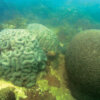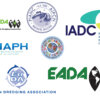Conventions are treaties that regulate a broad range of maritime areas which also impact dredging operations.
The London Convention
The “Convention on the Prevention of Marine Pollution by Dumping of Wastes and Other Matter, 1972” (the London Convention for short) and the London Protocol agreed to in 1996 in order to further modernise, update the Convention and eventually replace it.
MARPOL Convention
The International Convention for the Prevention of Pollution from Ships, 1973, modified by the Protocols of 1978 and of 1997 (known collectively as MARPOL), addresses harmful substances, sewage, garbage and air pollution caused by emissions that may be related to climate change.
AFS Convention
The International Convention on the Control of Harmful Anti-fouling Systems on Ships (AFS) entered into force in September 2008 and regulates anti-fouling paints which are used to coat the underside of a ship to prevent sea-life such as algae and molluscs attaching themselves to the hull.
BWM Convention
International Convention for the Control and Management of Ships’ Ballast Water and Sediments” (BWM Convention), regulating the ballast water pumped into and released during voyages, which can result in the introduction of non-native marine species into the new waters where they can become invasive, often multiplying so quickly that they out-compete native species. This Convention will enter into force 8 September 2017.
RAMSAR Convention
The Convention on Wetlands of International Importance, known as the RAMSAR Convention, is the intergovernmental treaty that provides the framework for the conservation and wise use of wetlands and their resources. The Convention was adopted in the Iranian city of Ramsar in 1971 and came into force in 1975. Since then, almost 90% of United Nations member states, from all the world’s geographic regions, have acceded to become “Contracting Parties”. It is the oldest of the modern global intergovernmental environmental agreements. Because dredging works often take place in wetland environments, this convention has had a notable impact on the development of sustainable dredging processes.
Mission
The Convention’s mission is “the conservation and wise use of all wetlands through local and national actions and international cooperation, as a contribution towards achieving sustainable development throughout the world”.
Wetlands
Wetlands are amongst the world’s most diverse and productive ecosystems. They provide essential services and supply all our fresh water. However they continue to be degraded and converted to other uses.
The Convention uses a broad definition of wetlands. It includes:
- all lakes and rivers,
- underground aquifers,
- swamps and marshes,
- wet grasslands,
- peatlands,
- oases,
- estuaries,
- deltas and tidal flats,
- mangroves and other coastal areas,
- coral reefs, and
- all human-made sites such as fish ponds, rice paddies, reservoirs and salt pans.
Under the “three pillars” of the Convention, the Contracting Parties commit to:
- work towards the wise use of all their wetlands;
- designate suitable wetlands for the list of Wetlands of International Importance (the “RAMSAR List”) and ensure their effective management;
- cooperate internationally on transboundary wetlands, shared wetland systems and shared species.
OSPAR Convention
Beginning in the 1950s, various scientists began to warn that oceans were not limitless areas for disposal of wastes and that to continue to act that way threatened the very survival of the marine environment. Many environmental groups began to demand that all waste disposal in the marine environment cease. The initial focus was on disposal of waste chemicals and nuclear wastes or incineration at seas of waste organo-halogen compounds. Subsequently, the disposal of sewage sludge and the large volumes of dredging materials, particularly those from heavily industrialised urban centres led to demands that these materials also not be permitted to be placed in the oceans.
Such demands were not limited to the oceans; for example, in the early 1970s both the United States and Canada limited the relocation of dredged material from the Great Lakes to confined shoreline or upland facilities with very little material being permitted to open water.
OSPAR started in 1972 with the Oslo Convention against dumping and was broadened to cover land-based sources and the offshore industry by the Paris Convention of 1974. OSPAR is so named because of these original Oslo and Paris Conventions ("OS" for Oslo and "PAR" for Paris).
The two conventions were unified, up-dated and extended by the 1992 OSPAR Convention. The convention has specific guidelines for the management of dredged material, its placement and monitoring.
The new annex on biodiversity and ecosystems was adopted in 1998 to cover non-polluting human activities that can adversely affect the sea.
The fifteen member Governments are Belgium, Denmark, Finland, France, Germany, Iceland, Ireland, Luxembourg, The Netherlands, Norway, Portugal, Spain, Sweden, Switzerland and United Kingdom.
Thirteen regional marine environmental protection conventions
In addition, to the OSPAR Convention, which govern two sea areas, the northeast Atlantic Ocean and the North Sea, thirteen other regional marine environmental protection conventions are in effect for specific parts of the world. Most of these conventions give guidelines for the disposal of dredged material at sea. Further guidance on these regulations can be found in chapter 6 of Dredging for Sustainable Infrastructure (edited by CEDA/IADC).
TAGS
Subjects
Regulatory Bodies, Agencies, Commissions and Organisations
-
 Conventions
Conventions
-
 IADC Dredging in Figures Committee
IADC Dredging in Figures Committee
-
 Dredging and Related Organisations
Dredging and Related Organisations
-
 Financial Institutes & Lending Agencies
Financial Institutes & Lending Agencies
-
 IADC Sustainability Committee
IADC Sustainability Committee
-
 IADC Indexation Cost Standards Committee
IADC Indexation Cost Standards Committee
-
 IADC Legal Committee
IADC Legal Committee
-
 IADC Public Relations Committee
IADC Public Relations Committee
-
 IADC Registered Plant Committee
IADC Registered Plant Committee
-
 IADC Safety Committee
IADC Safety Committee
-
 United Nations Environmental Programme (UNEP)
United Nations Environmental Programme (UNEP)






